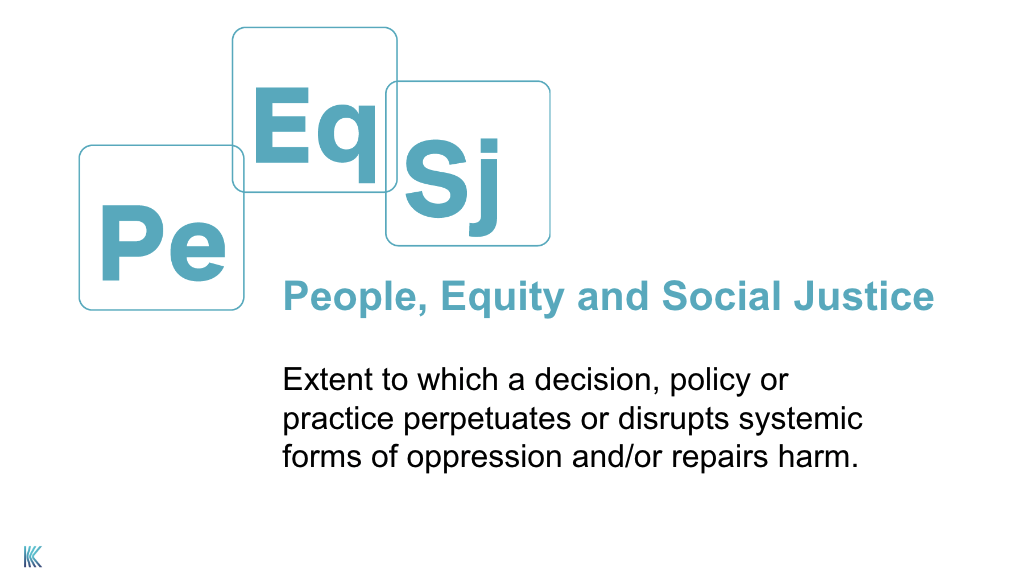Applying The Fourth Container: People, Equity and Social Justice, requires building your courage muscle. Why? Because applying The Fourth Container invites us to diverge from our traditional ways of thinking. And, when organizations break from previously accepted norms, it can evoke feelings of fear and uncertainty in their stakeholders.
Much as we would like to believe we operate within a meritocracy–a system in which each person’s individual effort will yield results matching their effort–the reality is that organizations do not. Instead, we operate within systems and institutions built on past and present inequity and inequality. While the systems that exist now weren’t originated by most of us currently working within them, we inherit the responsibility to improve them. In other words, since we now know better we have a collective responsibility to be better.
We’ve already established that being better means evolving your mindsets (how you think), skill sets (what you know/know how to do) and behaviors (how you show up to others).
People want to work for, buy from and donate to organizations who act in ways that align with their personal values.
Making thoughtful statements and taking informed action to advance people, equity and social justice today transforms organizational cultures for greater success tomorrow. Let’s consider two practical examples showing how you can apply The Fourth Container.
First, we’ll apply The Fourth Container to consider the U.S. Supreme Court’s decision on Roe v. Wade. Healthcare is a system in which it has been well-documented that people of color often do not have the same experiences as white people, which extends to maternal health. Unfortunately, all people of color are likely to experience poorer health outcomes compared to white people throughout their lifetimes. In other words, there are some persistent negative consequences for people of color arising from inequity and inequality in our healthcare system. When we consider factors related to reproductive care, including income, age, race, location and access to care, people of color are disproportionately impacted at higher rates than white people.
Doing a few minutes of homework to search for data like this is important, since many organizational leaders would be otherwise unaware that the Roe v. Wade decision has serious implications for social justice Acknowledging these facts makes us more effective leaders and decision makers regardless of what policies or benefits we choose to extend to our employees and how we choose to communicate with our stakeholders.
Secondly, differences in pay equity within organizations are one of the most common social justice issues over which employees may raise concerns with leadership. Most organizations claim equitable pay practices regardless of employees’ gender identities, but SHRM reports that only three out of five organizations have voluntarily done an actual pay audit to validate the impact of their practices. Sometimes organizations are reluctant to perform an audit due to their concern about what might happen if any pay inequities were to be discovered. The same SHRM study found that 83% of organizations take corrective action to adjust employees’ pay following such an audit.
Taking corrective action to ensure everyone is equitably compensated seems the right thing to do. On the other hand, some organizations may fear they will be vulnerable to legal action if employees are unsatisfied with corrective action. There is no action in this scenario that doesn’t come with some degree of potential risk. But, when organizations avoid doing a pay audit out of fear and pay inequities are allowed to continue as result, a social justice deficit grows.
A social justice deficit is the cumulative total cost incurred due to persistent, systemic inequity and inequality. Much like what happens when the federal government runs too high of a fiscal deficit, failure to reduce a social justice deficit today eventually may jeopardize organizational prosperity in the future.
People notice when organizations avoid doing their share of the work to narrow a collective social justice deficit or are going about reducing their own social justice deficit half-heartedly. For example, when leaders move to action too quickly and without involving the experts, we can end up taking well-intentioned steps that don’t reduce the deficit. It’s vital to acknowledge that in this case, the experts are the people most directly impacted by a social justice issue. The experts should inform what actions we can take so those actions will successfully translate into real, sustainable, long-term progress.
Here are some Fourth Container questions to help you take actions which are more likely to reduce instead of adding to your organization’s social justice deficit:
- What are the short term and long term impacts of this solution (e.g. our existing policy, current benefits provided, actions we plan to take now, etc.) for the organization?
- Will this solution increase equity for the people most impacted by the social justice deficit? If not, then for whom?
- Have we done our homework to research the facts and earnestly sought to understand competing sources of data and information?
- Have we directly engaged the experts (aka people most impacted) in designing or evaluating the solution?
Transforming systems and organizational cultures is hard work and requires taking a long term view of organizational success. It is also necessary work because while tolerating the status quo will be more convenient and more comfortable for some stakeholders in the short term, it doesn’t position the organization for success in the long term. Download our Introducing Learn Lead Lift® Bundle and discover how to future-proof your leadership.
New to this series of articles about The Four Containers? Check out Introducing The Four Containers , The First Container: Bodily Autonomy and Personal Agency , The Second Container: Business, Legal, and Financial Exposure to Risk and Upside and The Third Container: Institutional Structures and Systems.


 Heather Leavitt-Martinez (she/her/hers) – Senior Product Manager
Heather Leavitt-Martinez (she/her/hers) – Senior Product Manager Wendy Ryan (she/her/hers) – CEO
Wendy Ryan (she/her/hers) – CEO Shawn Bunger (she/her/hers) – Senior Consultant
Shawn Bunger (she/her/hers) – Senior Consultant Crystal Whiteaker (she/her/hers) – Senior Consultant
Crystal Whiteaker (she/her/hers) – Senior Consultant Gail Finger (she/her/hers) – Senior Consultant
Gail Finger (she/her/hers) – Senior Consultant Monica Silkwood (she/her/hers) – Director of Operations and Experience
Monica Silkwood (she/her/hers) – Director of Operations and Experience Johanna Lyman (she/her or they/them) Senior Consultant
Johanna Lyman (she/her or they/them) Senior Consultant Sherri Horan (she/her/hers) – Senior Consultant
Sherri Horan (she/her/hers) – Senior Consultant